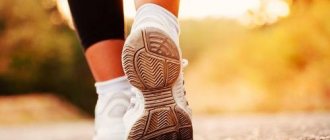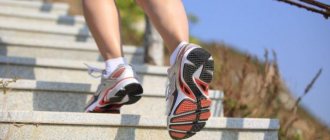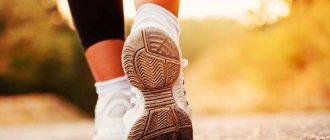This article was prepared by our beloved partners - the #GMfood - an online store of superfoods and craft eco-products.
Just for registering in the store you will receive 300 rubles to your personal bonus account and 2 more interesting gifts (Grab your gifts here)In the store's assortment you will find not only superfoods, but also healthy sweets, breakfasts, herbal teas, peanut butter, master classes for body health and facial beauty, and this is only a small part of the goodies and benefits!
Subscribe to Instagram #GMfood using this link and regularly receive new PP recipes with superfoods, see useful guides to the world of proper nutrition, and also look for gifts hidden under the link in the profile!
What is better, running or walking for weight loss?
Some people find walking ineffective for losing weight and therefore choose running. But walking is definitely healthier for your health. While running, there is a load on the spine, lungs, heart, and joints. The heart undergoes training, breathing becomes deep and rapid, blood flows through the veins more actively, and the lungs open. And all this speeds up the process of burning calories that entered the body during the day.
You need to run at least 20 minutes a day. It is during this time that the energy components contained in the liver and muscles will begin to be burned. This means that the body will need more energy, and it will take it from subcutaneous fat. Gradually, the duration of the races should be increased.
Running with breaks is also effective. That is, fast running should be alternated with slow walking. In this case, weight is lost and the cardiovascular system is trained. If a person walks for a long time, even at a slow pace, the blood sugar level changes. When reserves are depleted, the process of lipolysis turns on and fat begins to break down, releasing water, energy and carbon dioxide. A person sweats, and all together speeds up metabolism.
Metabolism is the exchange of substances and energy in living organisms.
Source Wikipedia
To lose weight, it is important that energy is consumed as quickly as possible. And physical activity for 1 – 1.5 hours will help with this. To lose weight faster, of course you should choose running, but it is not suitable for everyone.
Walking is less effective. To achieve a positive result, you will have to walk at a fast pace. But in any case, the effectiveness of running and walking is undeniable.
conclusions
Now you know - the question of what is more effective for losing weight - running or walking - is not correct in its essence. To lose weight, you need to burn calories, and how you do this is determined by your physical condition and level of training.
For the vast majority of non-professional athletes, walking to lose weight is an effective and safe option. Nordic walking is even more effective and has a number of additional advantages. But here you will have to acquire equipment.
- 1.Judy A. Driskell, Ira Wolinsky. Sports Nutrition: Energy Metabolism and Exercise.
- 2.JR Poortmans. Principles of Exercise Biochemistry.
- 3. Evgeny Milner. I choose running!
- 4.Alex A. Lluch. Easy Workout Journal.
- 5.John B. West, Sukhamay Lahiri. High Altitude and Man.
- 6.Claire Walter. Nordic Walking: The Complete Guide to Health, Fitness, and Fun.
- 7.Timothy S. Church, Conrad P. Earnest & Gina M. Morss. Field Testing of Physiological Responses Associated with Nordic Walking.
Difference between walking and running
How is walking different from running?
- When you run for more than 25 minutes, the fat burning process begins to work. The body uses all the sugar in the bloodstream;
- During running, a heavy load is placed on the cartilage tissue;
- While running in a stressful state, a person receives psychological relief, and when walking this load is much less;
- When walking, many muscle groups are involved: shoulders, buttocks, legs;
- You can walk longer than running and your heart rate will be lower;
- While running, you need to monitor your heart rate. For a person under the age of 40, it should be no more than 120 - 140 beats per minute. In this range, fat is burned most efficiently and in a shorter period of time.
Features of choosing sticks
Residents of Scandinavian countries have used similar ski poles for many years while walking and training. Nowadays, stores offer several types of this sports equipment, and everyone can choose the best option for themselves. Scandinavian walking poles, the benefits and harms of which will be described below, must be chosen based on your height, terrain, etc.
- Weight. Some are heavier, others are extremely light. Additional components such as pads, shock absorbers and others add weight, which should be taken into account when purchasing.
- Materials. Aluminum and carbon fiber are in great demand. Each differs in terms of shock absorption, durability, and weight.
- The length of the pole is more important for the ability to use the technique of this sport in the right way. A stick with a standard length without the ability to change the parameter is usually the lightest, since it does not have additional elements. But it should only be used for flat terrain, since in other cases it will not give the desired support effect, but will only get in the way under your feet. For those who like to travel or explore new areas, telescopic models with a position locking system are more suitable.
- Professional gloves are used to protect hands from rubbing with sticks. Gloves are selected according to size, as they should not cause discomfort. The design is constantly improving, so you can choose a stylish and modern option to suit every taste.
- Additional elements. These include spikes for nature trails and overlays for sidewalks or walkways. Rubber pads are essential for asphalt, paving slabs, etc.
Professional pole models are also equipped with shock-absorbing springs.
They add weight, but make the workout much easier to use and more effective. Find out the causes of excess weight and ways to quickly lose weight
Sign up for a free initial appointment with a nutritionist!
Beginning athletes are recommended to take Nordic walking classes without poles. After all, they only contribute to the activation of body movements. First of all, it is recommended to simply start walking in this mode and understand whether this sport is suitable for the body. In addition, you should not buy everything you need if it will only be used a couple of times.
Running or walking - which is more effective for losing weight?
Many overweight people don't like to run.
Why? Yes, because it's hard.
Running is an intense cardio workout. It increases your heart rate, thereby helping you burn calories. But it wears out the joints and the spine suffers from it.
As strange as it may sound, walking also helps you lose weight, but only if you walk quickly. Walking is absolutely safe for health. While walking, the load on the knees and spine is minimal. In addition, brisk walking trains the heart muscle.
Walking is easier than running, and at first you will burn more calories than running.
So what is actually more effective – running or walking?
If you run for the same amount of time as you walk, running will certainly be more effective. But running may be contraindicated for people who have problems with the spine and knees. Walking is safe for the body.
It is very important to learn to walk correctly. Correct walking means maintaining posture when walking, a harmonious combination of the amplitude of the arms and legs. While maintaining this position, the load on the musculoskeletal system is balanced.
A little about the energy supply of muscle work
Almost any healthy person can walk a half-marathon (42 km 195 m) without stopping, because during low-intensity exercise fats are primarily used for energy. But running this distance at speed (running) requires developed energy exchange, which is achieved through regular training and is no longer possible for everyone.
However, fats are not the only source of energy in the body. There are also carbohydrates (glycogen), creatine phosphate (creatine phosphoric acid, a metabolite of creatine) and ATP (adenosine triphosphate, the main carrier of energy at the cellular level). They are used and spent as follows1:
- – Fats
– during low-power loads (just walking), the working time is potentially inexhaustible. - – Carbohydrates
– with an average power load (moderate running), work time is limited by the amount of accumulated glycogen in the muscles and the rate of its accumulation. For trained people, it lasts 1.5-2 hours. - – Creatine phosphate
– with high power loads, sprints and strength work for up to 10 seconds. - – ATP
– with maximum power load, these are jumps, jerks, throws, powerlifting exercises – work lasting up to 2 seconds.
This is a simplified idea, all energy sources in the body are interconnected - their work and interaction is explained in detail at the level of biochemistry by the Cori cycle2. Another thing is important for us - carbohydrates, creatine phosphate and ATP are consumed in appropriate cases and at a certain speed, fats - always and with the same intensity.
That’s why, from a biochemical point of view, the question of which is better for losing weight—running or walking—sounds simply stupid. Fat can be consumed in hundreds of ways, the question is how to do it more comfortably and safely.
Why fast walking is more effective than running
It has been scientifically proven that brisk walking is much more effective than running in the fight against excess weight. For people who prefer to walk a lot, the risk of developing cardiovascular diseases is reduced by 7.2%, and for people who like to run – by 4.2%.
Those who want to lose weight should know that in this case, brisk walking is much more effective than running.
When walking, fat disappears faster than when running. This happens because while running the upper threshold of the permissible heart rate is reached. And at this time the body goes into a mode of increased glucose consumption. And when a person walks at a brisk pace for an hour, fat cells come into action and give off their energy.
Walking is accessible to everyone. You can walk at any time when it is convenient for you. But in the absence of restrictions, running is still more effective. But we must remember that running is more dangerous than walking, because it puts more stress on the joints.
What's the result?
So, we see that both running and walking are equally beneficial for improving health, provided that you spend the same amount of energy.
Therefore, if you have excellent health and stamina and are ready to go out for training at least 3 times a week - run! You will lose extra pounds faster, however, you will have to put in a lot more effort.
If you are not ready for such excessive loads, then introduce walks into your life. You can walk anytime, anywhere, in any weather, and it’s also safe for your health. At the same time, you will get rid of fat without damaging your muscles. And you don't have to force yourself or make any effort!
While you are just walking briskly, colossal changes occur in your body - blood pressure normalizes, blood cholesterol levels decrease, memory improves, immunity and stress resistance increase. And if you practice interval walking - that is, periodically changing the pace of movement - then calories will be burned even faster, even after the end of the workout.
Well, if you are equally attracted to both running and walking, then why not combine them in interval training? Start with a brisk walk, then increase your speed a little to jogging, and then push yourself as fast as you can. This will help you burn fat faster.
In any case, whatever type of physical activity you choose, stick to regularity - exercise for 30-60 minutes at least 3 times a week. And then the result will not take long to arrive! Happy and comfortable training to you!
The benefits of running
Running is one of the most accessible ways of physical activity.
It has a lot of advantages:
- Strengthens the heart muscle, respiratory organs and leg muscles. As a result, blood circulation and oxygen supply to organs improves;
- Trains endurance and willpower;
- Helps cleanse the body of toxins that come out with sweat;
- Helps to lose weight;
- Helps cope with depression, because during running the hormone of happiness, joy and pleasure - dopamine - is released. It controls our secret desires and influences libido;
- Has a beneficial effect on the immune and nervous system;
- Running in the fresh air strengthens you.
The disadvantage of running is that it is contraindicated for people with serious chronic diseases.
What is this sport used for?
Correct body movements during this walk will help relieve tension in the neck and shoulders, while the muscles of the torso will remain in good shape. Works the deltoids, pectorals, triceps, biceps and abdominals. Calorie burning increases up to 40 percent, but the load on the body does not increase. On the subject: How to remove stretch marks after losing weight Using the correct Nordic walking technique with relaxed shoulders, holding the poles correctly and using the full range of motion, the function of the neck and shoulders is restored. Just 30 minutes is enough to forget about back pain. This sport is also actively used to burn fat. During training, 30% more calories are burned and the effect of muscle work increases up to 40%. The undeniable benefits of Nordic walking are visible after just a couple of weeks of training.
What are the benefits of walking for weight loss?
People who periodically go on diets, drink diuretics, and go to steam rooms in the hope of losing weight will not be able to achieve positive results without physical activity. Muscle fat is burned only through physical activity.
Many people believe that it is impossible to lose weight by walking. They cannot understand how this is possible if working out in the gym, running in the morning, or swimming cannot solve this problem?
The benefits of walking are undeniable.
- It affects human health and well-being. During walking, fat oxidation occurs in the muscles. The more a person moves, the more active fat burning occurs;
- 1 hour of vigorous walking will change the level of hormones that regulate appetite - ghrelin (stimulating appetite) and peptide (reducing it). While walking, the level of ghrelin decreases, and the level of the peptide increases, and the person does not feel hungry;
- Regular walking activates hormones that promote fat breakdown;
- Muscle tone increases, which leads to greater energy expenditure;
- Daily walking for half an hour a day reduces the risk of tumors in the intestines by 30%;
- Has a beneficial effect on the functioning of the heart;
- Walking reduces the likelihood of varicose veins;
- Strengthens the bone skeleton and the entire musculoskeletal system. Promotes better absorption of calcium, with constant load the ligaments are strengthened;
- Increases calorie expenditure. Within an hour, approximately 200–300 kcal are consumed while walking.
Points You Should Keep in Mind When Walking for Weight Loss
To get your figure in order by walking, you will have to try. But the main thing is not to harm the body. Therefore, it is recommended to follow the basic rules. Keeping your steps consistent and clear will help you maintain momentum throughout the session. At first, count and march. Observe the sensations in your neck and back. There should be no tension, discomfort, or pain. To avoid cramps and discomfort in the leg muscles, it is recommended to do light stretching every half hour. When walking, place your entire foot on the ground.
The main thing is not to get upset if something doesn’t go according to plan. Over time, daily walks will become habitual and will bring only joy.
Walking therapy
European doctors prescribed health-improving walking to patients with various diseases back in the early 19th century. They prescribed regular walks along the seashore, along the hills and mountains.
The advantage of walking therapy is that it can be done in any area and at any time of the year. And you don’t need exercise equipment or additional equipment for this. It is enough to have a pair of comfortable shoes.
Benefits of healthy walking
Walking is the best option for overweight people or for those who have just decided to take up exercise. A person can independently control the load, set the desired speed and distance.
Walking therapy can be combined with walks in nature, going to the store or to work.
If the body is weakened after an illness, it is recommended to start classes with a preparatory type of health walking. It must be performed at a slow pace - 60 - 80 steps per minute. At the same time, monitor your pulse and breathing rates.
Gradually, the intensity of movements must be increased and after some time you can switch to the main type of therapeutic walking. Its essence lies in alternating fast (more than 100 steps per minute) and slow walking. At the beginning of the movement, the speed should be comfortable, breathing should not be interrupted. Walk at a slow pace for 5 - 10 minutes, then go to a fast pace for 3 - 5 minutes, after that - again to a slow one.
Before starting class, you need to warm up for 10–15 minutes. The lesson should last 30 – 40 minutes. Finally, there is a stage of slow walking, muscle stretching, breathing and relaxation exercises.
During healthy walking, calories are calculated depending on body weight and speed of movement. At an average walking pace:
- 4 km/hour approximately consumes 3.2 kcal for each kg of weight;
- 6 km/hour – 4.5 kcal;
- 8 km/hour – 10 kcal per 1 kg of weight.
Those who are unable to determine the distance traveled can calculate energy expenditure based on the number of steps per minute:
- 50 steps is approximately 3 km/hour;
- 66 – 4 km/hour;
- 83 – 5 km/hour;
- 100 – 6 km/hour.
To calculate energy costs, you can use fitness bracelets, trackers and software in mobile phones.
In order to accurately calculate calorie consumption, you need to enter your weight, gender, age, and walking speed.
The energy consumption of the body is increased by weights, more difficult routes, and additional exercises while walking.
Tips for beginners
Anyone can practice walking to lose weight: both a pensioner and a very overweight person. This is the most affordable way to lose weight of all known. But before starting training, it is recommended that you read the information below.
How long to walk
The walk can last for an unlimited time. There is no upper limit on duration or distance: travel as many kilometers as you feel necessary. The main thing is not to overdo it. Classes begin with hikes over shorter distances, then gradually lengthen them. The body itself will tell you when you need to increase the duration of your workouts.
For an untrained person, a speed of 3-4 km per hour or walking in place at his usual pace is sufficient to achieve the effect. More trained persons or representatives of physical labor can move at a speed of 6-8 km/h.
If you experience discomfort, pain, severe palpitations or shortness of breath, it is recommended to stop any physical activity. If the condition does not improve after this, you should seek medical help.
To “start” fat burning processes, you need to walk for at least an hour a day. In 30-40 minutes, the body, in order to meet increased energy needs, will be forced to switch to breaking down fat reserves.
Accordingly, already at the initial stage of training, about half an hour will be allocated for burning fat, which will allow you to effectively fight excess weight.
Over time, as opportunities grow, walks can be increased. You also need to gradually increase the pace of movements. You yourself will feel the need to increase the duration and intensity of your studies, which will be expressed in an ever-increasing desire to go further, which will be increasingly difficult to resist. The need to increase the intensity and time of training will be indicated by the ease of tolerance of previous loads, the feeling that not everything has been accomplished and there is an opportunity to do more.
If you want to burn more calories, it is advisable that walking becomes a part of your life: walking to the store, place of work, amusement park, restaurant, cinema, etc.
We provide you with an approximate walking program for a month to burn calories. The given program is an example - it is not necessary to repeat it completely. All training must be individualized. The intensity of the exercise should be adjusted in accordance with the reaction and needs of the body.
Week 1:
- Day 1. Slow walking for 30-40 minutes (the day is considered a preparatory day; based on its results, the ability to train further is assessed).
- Day 2: Walk slowly for an hour.
- Day 3. Slow walk 1-1.5 hours.
- Day 4. Workout at a moderate pace for about half an hour (the possibility of increasing the load is considered).
- Day 5. Moderate walking pace for 1-1.5 hours with rest breaks.
- Day 6. Walk at a moderate pace for 1.5-2 hours with breaks.
- Day 7. Rest or walk at a slow pace.
Week 2:
- Day 1. Walking at a moderate pace for at least 1 hour (then walking should be at least 1 hour per workout), performing breathing exercises.
- Day 2. Walk with interval walking + breathing exercises.
- Day 3. Interval training with breathing and light physical exercise (jumping, squats, etc.).
- Day 4. Walk at a high pace of walking + breathing exercises (tolerance of a high pace of walking is assessed).
- Day 5. Training at a moderate pace with free exercises.
- Day 6. High-intensity class + light exercise.
- Day 7. Rest or walk at a moderate pace.
Week 3:
- Day 1. Interval training with strength exercises.
- Day 2. High-intensity walking with light physical exercise (up to half an hour).
- Day 3. Walking at a moderate pace and strength exercises + breathing exercises.
- Day 4. Walk at a high pace with breathing exercises.
- Day 5. Interval walking, strength exercises (10-15 minutes).
- Day 6. High-intensity walk, free exercise.
- Day 7: Rest or walk at a moderate pace.
Week 4:
- Day 1. Interval training with strength and breathing exercises.
- Day 2: High-intensity walk with floor exercises.
- Day 3. Interval walking + strength exercises for at least 30 minutes.
- Day 4: Interval training, free exercise or breathing exercises.
- Day 5. Walk at an intense rhythm with strength training.
- Day 6. Interval walk, free exercises.
- Day 7. Rest or easy walk.
When to go
It is advisable to choose the training time according to individual biorhythms rather than the general population. Although there is an increase in the concentration of hormones in the body in the pre-dawn hours, which is a kind of wake-up signal, not everyone is comfortable waking up early in the morning. A similar picture is observed with going to bed. It is important to take into account the work schedule, since after an active workout it can be difficult to “join” it.
The advantage of morning workouts over evening classes is the speedy transition to the “calorie burning” mode. However, training on an empty stomach is prohibited, although such an approach may seem irrational. Exercising on an empty stomach disrupts the functioning of the gastrointestinal tract and leads to disruption of its physiological rhythm of work. Therefore, before your morning workout, it is advisable to have a light breakfast.
Evening exercises allow you to get rid of negative emotions accumulated during the day, relieve mental and physical stress, and have a beneficial effect on sleep. Their disadvantage is the longer process of “building up”, the need for a more thorough warm-up. Also, the body takes longer to get used to the evening exercise routine. It is important that training takes place no later than 3 hours before bedtime, otherwise you can disrupt biological rhythms and harm the cardiovascular and endocrine systems.
It is highly undesirable to train at lunchtime, since then the greatest solar activity is observed, which negatively affects the body.
Exercising in the heat is especially dangerous, as it leads to severe loss of fluid, puts excessive strain on the heart and respiratory system, and can lead to overheating and other dangerous consequences.
Where to go
It doesn’t matter where the classes take place. You can walk anywhere convenient:
- at home;
- on the staircase;
- on the street (away from the roadway);
- at the stadium;
- in the gym on a treadmill;
- on the bank of a river or lake;
- in the park.
The main condition is the presence of clean air, since heavy gases and impurities from the air entering the lungs impair breathing, additionally load the cardiovascular system, and reduce the effectiveness of training.
Clothes for walking
Proper walking for weight loss begins with choosing clothes and shoes. The latter plays a special role. It must correspond to the size (no squeezing or dangling of the foot), provide fixation of the ankle joint, but not limit movement in it. It is undesirable to wear shoes with completely flat soles, since they do not allow physiological distribution of the load on the foot and lead to compression in the direction from bottom to top. Also, shoes should be soft. It creates the effect of a soft spring - it performs a shock-absorbing function. Otherwise, the risk of developing flat feet, injuries, and increased wear of articular surfaces increases.
Shoes should not be too heavy or light - they need to be felt. It is advisable to use sneakers. They should be changed every 400-450 km, because by this time they have time to wear out and lose their shock-absorbing function.
Clothes should be comfortable: not tight to the body and not hanging. Natural fabrics are recommended because they allow air to pass evenly (the fabric “breathes”) and ensure normal sweat production and evaporation (the body cools naturally). Dark fabrics heat up more, so wearing them in hot weather is not advisable. Light-colored clothing heats up less, so it is more suitable for activities in the warm season. In cold weather, it is recommended to wear hats.
Clothes and shoes must be appropriate for the weather, otherwise training will lead to illness.
Warm-up
Warm-up is a must. It is especially relevant for interval training, walking at a fast pace or on stairs. Loading on unheated muscles leads to excessive damage to their fibers and increases the recovery period. Sudden stress on joints, ligaments and bones can cause severe damage. Without warming up, the likelihood of injury increases by 2-3 times.
You should start the lesson with light breathing exercises, warming up movements in the joints (necessarily in large ones), rotations of the neck and pelvis, squats, and muscle stretching. Everything is like in school physical education classes. Then they move on to slow walking for a short distance, soon increasing the pace. Be sure to monitor your health, breathing and heartbeat. Afterwards, you can rest for up to 5-8 minutes before the main workout. In addition, warming up will allow you to burn more calories.
Walking technique
It is extremely important to know how to walk correctly. Although this seems strange, many people do not know how to walk, which is why exercise will only be harmful to their health.
The correct walking technique is as follows:
- Correct posture. You need to stand straight, do not arch your back or lean forward, otherwise the stress on your feet and spine will increase by 1.5-2 times, which increases damage to bone and cartilage tissue. Correct posture will ensure easy breathing and avoid pain in the legs and back.
- Chin parallel to the ground, gaze straight. This ensures reliable fixation of the cervical spine, which minimizes the likelihood of injury. Looking ahead will allow you to respond in a timely manner to the appearance of an obstacle.
- Shoulders relaxed. They are located freely or slightly retracted posteriorly (depending on the flexibility of the joints). Walking with a tense shoulder girdle causes excessive shock to internal organs.
- The abdomen is tucked, but not tense. This achieves the effect of a pillow - the internal organs are maintained in a physiological position, their shaking is minimized.
The efficiency of burning fat while walking or running increases when you engage your arms. According to various sources, this increases the effectiveness of classes by 4-10%. The limbs are bent at the elbow joints at a right angle. If this technique is too exhausting, you can use your hands for 5-15 minutes until the body gets used to the increasing loads.
- It is forbidden to clench your fists. Clenched fists increase blood pressure, which is highly undesirable. It is recommended to keep your elbows close to your body.
- The feet should be parallel to each other. This will protect the joints from premature wear.
- Walking involves rolling from heel to toe. First, the heel is lowered, then the foot rolls towards the toe. If there is simultaneous contact with the surface of the entire foot, it is worth reviewing the technique or changing shoes.
- The steps are moderate. A step that is too long or short disrupts balance and increases the load on the foot. The repelling limb should be at a greater distance from the body, because the pushing force is placed on it.
- Breathing should be of moderate depth and uniform. Sharp inhalations and exhalations lead to shortness of breath and the training will have to be stopped. The appearance of severe shortness of breath, discomfort or pain in the lungs is a signal to reduce the intensity of training or to stop it.
- The heart rate should not exceed the maximum for a particular age.
- There is a concept of the “fat-burning pulse zone” - the heart rate at which maximum burning of fat reserves is achieved. The “fat burning zone” is considered to be a heart rate corresponding to 60-70% of the maximum safe frequency. The “fat burning zone” can be determined using the formula 220 beats/min. subtract the age in years (get the safe heart rate limit for a specific age) and multiply by resp. percent.
- Walking speed should be increased gradually.
How much water to drink
Replenishment of water and mineral losses is mandatory. Most of the salts dissolved in water are excreted from the body through sweat. In the absence of their supply, problems with the heart and nervous system are observed, and seizures may develop.
You can drink before starting a workout. But a little. Otherwise, breathing is impaired, and the load on the heart and kidneys increases significantly. It is recommended to drink small sips (3-5) during training. Do not drink too much water, otherwise you will have to stop the activity.
After training, it is necessary to restore the water-mineral balance. Freshly squeezed juice or mineral water (preferably without gas) will help. You should not drink a lot of liquid at once. It is better to drink the same amount in short periods of time. For the average person, 0.5 to 1.5 liters of water per workout is enough to replenish fluid loss.
Drinking sports drinks with caffeine is highly discouraged. Because they overload the heart muscle and lead to increased blood pressure.
Goal while walking
Each workout should pursue a specific goal, which will make it more effective and make it easier to bear the load. It is recommended to set yourself a small task each time. For example: walk to a certain street, cover 10 km or climb a hill 5 times. This approach will allow you not to miss training, develop resilience and the habit of achieving what you want. Quite quickly, the psyche will get used to the formation of regular tasks, which will allow you to constantly improve your results.
Motivation
Walking is an affordable and completely free way to normalize body weight. The only thing required is desire. Regular exercise will not only help you get rid of fat deposits, but also improve your health, develop strength and endurance. It has been proven that playing sports builds strong-willed qualities, allows you to fight stress, and discover hidden potential. At the very least, it will become a useful hobby. If you walk accompanied by music or audio books, you can significantly expand your worldview.
Joint training allows you to make new acquaintances, motivate each other, and strengthen relationships. It is noted that during joint exercises, load tolerance increases, therefore, productivity increases.
How to walk correctly: some tips
Not everyone has a park or forest nearby, and they have very little free time. Will you really have to give up walking for the sake of work? Start with the road to work: it is probably possible to cover part of the route on foot. If possible, use your lunch break to walk.
Get out into nature as much as possible on weekends and holidays. Plan trips to change your surroundings and simply walk around new areas. It is not necessary to go to expensive resorts: a neighboring city or village with a favorable natural environment will also be suitable for these purposes.
To get more walks, get yourself a four-legged friend. Among the “dog lovers” there are many fit and physically developed people, as they have to go for walks every day.
A pedometer will help you control your walking distance
How long should you walk to lose weight?
The daily minimum is 10 thousand steps, which equals 5-7 kilometers. Less is also good, but to start the fat burning process, you need to walk continuously for at least an hour.
Another important point influences weight loss: you need to walk in the “fat-burning” heart rate zone - this is 60-70% of the maximum (MP). To determine the working zone, you need to calculate the maximum threshold of your own heart rate. For example, if you are 30 years old: 220 – 25 = 195 – this is the maximum heart rate (MP) for you.
Knowing the MP, you can calculate the 60-70% working area for walking, for this 190 / 100 * 60 (70) = 114-133 beats per minute.
A pulse at the correct frequency gives better results - walking in the “fat-burning” pulse zone allows you to burn up to two times more fat .
It is worth understanding that a one-time walk will not bring results. To lose weight, you need to walk regularly, at least every other day, gradually accustoming yourself to daily walks.











